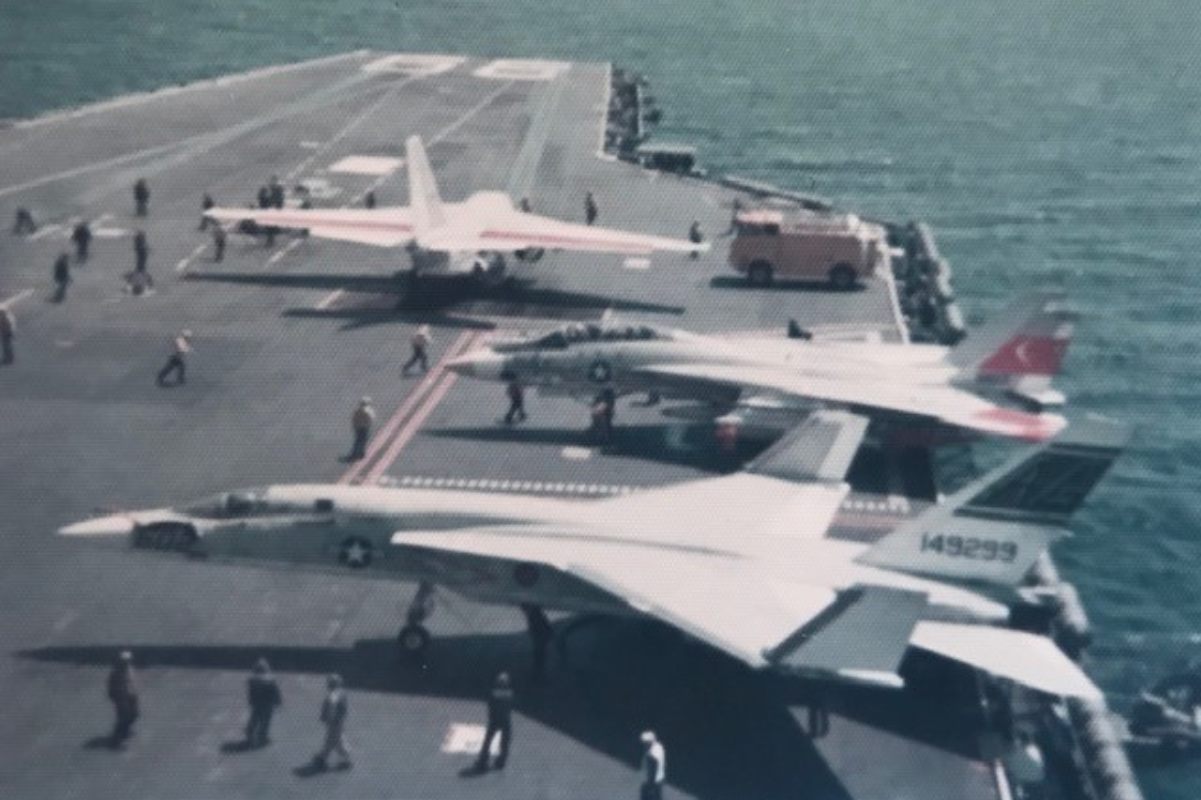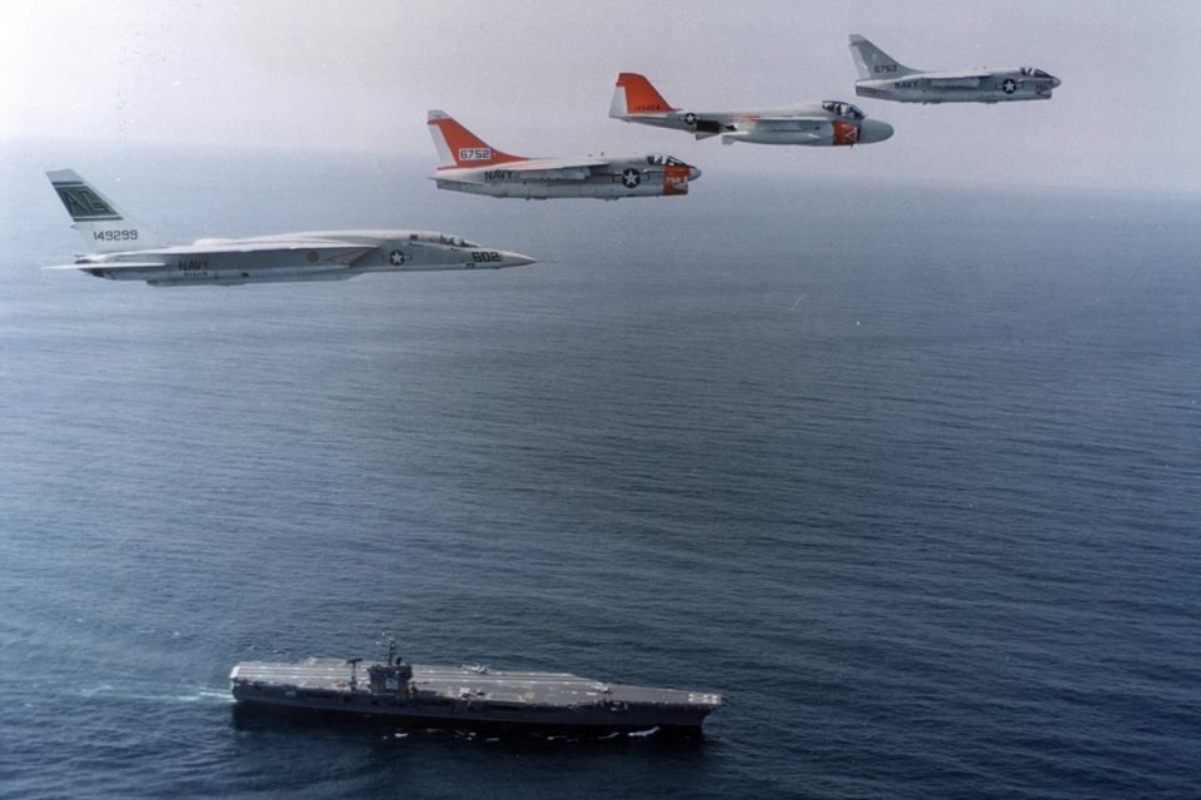The last thing a Navy pilot launching from an aircraft carrier wants is that sinking feeling as the jet descends too far below the flight deck at the end of the catapult stroke. What must happen behind the scenes to avoid that sinking feeling and allow the pilot to attain sufficient airspeed to fly away and proceed on the mission?
Minimum end airspeed
The US Navy has been safely launching aircraft off catapults for many years. This article will address a few key issues that must be addressed during a “minimum end airspeed” flight test program.
Minimum end airspeed is the key term. Technically the absolute minimum catapult end airspeed is the speed below which the airplane cannot maintain itself in the air, when flying off an aircraft carrier (or “boat”). Determining this is not as simple as searching for a figure in a pilot’s operating handbook like you could for stall speed or other flight data. That’s where the expertise of a team of test pilots and flight test engineers is needed to make it all happen.

Carrier Suitability Branch
The journey starts in Maryland at NAS Patuxent River, often called Pax River. That’s where the flight test professionals of the Carrier Suitability Branch (CVS) of the Naval Air Systems Command (NAVAIR) Air Test and Evaluation Squadron Two Three (VX-23) come into play. This organization maintains a land-based TC-7 catapult and a Mk-7 arresting gear to conduct a wide range of ground-based aircraft testing prior to further testing on the carrier. (See end note for details on this catapult and arresting gear.)
My career in flight test started with the CVS professionals and I was proud to be part of the team of pilots and engineers that conducted the initial carrier qualifications test on the USS Nimitz (CVN-68) in May of 1975. It is hard to believe that so many years have passed as the Nimitz is now approaching the end of its service to the US Navy. The CVS aircraft fleet at the time was extensive by today’s standards. We conducted flight testing on F-14, F-4, F-8, A-4, A-6, A-7, RA-5, S-3, and C-2 — all went through the catapult launch and recovery certification process before they began fleet ops.
Many aircraft factors

Flight test pilots and engineers must develop a thorough understanding of many aircraft factors including aerodynamic stall speed, thrust available, angle of attack (AOA), loading, center of gravity (CG) location, and rotational inertia. Then the shipboard factors must include catapult performance, bow, or waist catapult, and Wind Over Deck (WOD) measurement systems.
Consider the difference between the minimum end airspeed and the catapult launching envelope. The goal is to establish the lowest practical airspeed because it decreases the WOD requirement for a catapult launch, decreases the loads imposed on the aircraft, and decreases the energy that the catapult must deliver to the airplane. A cat shot typically generates up to 4 g and the airspeed will go from zero to 160 mph (257 km/h) in two seconds.
Aerodynamic tests
The absolute minimum catapult end airspeed calculations are pretty accurate but must be verified through a flight test program. In order to have the data available to make informed plans the aircraft must be heavily instrumented. Parameters can include basic parameters like airspeed, altitude, and AOA, but also pitch and roll attitude, pitch rate, rate of climb, and engine details.

Aerodynamic tests are first performed ashore at Pax River to establish limit conditions and pilot techniques. While many factors must be thoroughly understood, two factors of primary concern are the aerodynamic stall speed and the slow speed where the thrust available equals the thrust required.
Testing at NAS Pax River
Once this baseline data is established the next step is testing at the NAS Pax River land-based TC-7 catapult. Even though the pitching moments, trim, and ground effect influences will be different from shipboard launches, the data developed is still critically important as part of the overall flight test program.
The aircraft/catapult launch envelope must consider several factors. On the catapult side is the maximum capacity available. On the aircraft side considerations include the maximum design gross weight and longitudinal acceleration limit in both the clean and dirty configurations. The structural aircraft tow force limit is also a major consideration. For these reasons the determination of a minimum end airspeed is critical to flight operations on the boat.

Flight testing on the boat
Flight testing on the boat is the next critical step in the program. The flight deck is about sixty feet above the ocean so a margin of 4 kts above the absolute minimum end airspeed is the target for the shipboard tests. Based upon land-based testing at Pax River a starting point is established and gradually lowered in increments of 3 kts to reach the minimum end airspeed. Tests are then conducted at a range of aircraft weights and external loading. The aircraft external loading configuration can affect the minimum airspeed because of drag, rotational inertia, and wing/tail airflow interference.
NATOPS
Once the flight test program is completed the data is disseminated to the fleet in the form of Aircraft Launching Bulletins (ACLB) and Naval Air Training and Operating Procedures Standardization (NATOPS) Flight Manuals. Using the minimum airspeed as a foundation, the ACLB is generated with aircraft launched at 10-15 kts above the minimum end airspeed. This ensures that each catapult launch will be safe from an airspeed standpoint, providing confidence to the pilots that each launch will be a successful start to another mission complete objective.
The Future
Starting with the USS Gerald R. Ford (CVN-78) a new era began with the introduction of new catapults and arresting gear. The General Atomics Electromagnetic Aircraft Launch System (EMALS) and Advanced Arresting Gear (AAG) upgrades will offer many benefits. The advantages of the EMALS include less airframe stress, lower system weight, reduced maintenance, less energy needs, and quicker recharges which allow for increased sortie rates.
Note
The TC-7 catapult installation at NAS Patuxent River was completed in 1954, but has undergone continuous upgrades, so it is representative of the steam catapults used on most US Navy aircraft carriers. The TC-7 features a linear piston-type steam engine that can launch airplanes up to 85,000 pounds gross weight and attain launch endspeeds in excess of 200 mph. The Mark 7 Mod 3 arresting gear found on most US Navy carriers has the capability of recovering a 50,000-pound aircraft at an engaging speed of 130 knots (150 mph or 240 km/h) in a distance of 344 feet (105 m) in two seconds.
Photo by U.S Navy and Pat O’Brien

